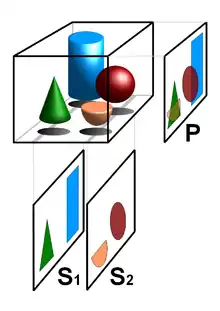Electron tomography
Electron tomography (ET) is a tomography technique for obtaining detailed 3D structures[1] of sub-cellular, macro-molecular, or materials specimens. Electron tomography is an extension of traditional transmission electron microscopy and uses a transmission electron microscope to collect the data. In the process, a beam of electrons is passed through the sample at incremental degrees of rotation around the center of the target sample. This information is collected and used to assemble a three-dimensional image of the target. For biological applications, the typical resolution of ET systems[2] are in the 5–20 nm range, suitable for examining supra-molecular multi-protein structures, although not the secondary and tertiary structure of an individual protein or polypeptide.[3][4]

BF-TEM and ADF-STEM tomography
In the field of biology, bright-field transmission electron microscopy (BF-TEM) and high-resolution TEM (HRTEM) are the primary imaging methods for tomography tilt series acquisition. However, there are two issues associated with BF-TEM and HRTEM. First, acquiring an interpretable 3-D tomogram requires that the projected image intensities vary monotonically with material thickness. This condition is difficult to guarantee in BF/HRTEM, where image intensities are dominated by phase-contrast with the potential for multiple contrast reversals with thickness, making it difficult to distinguish voids from high-density inclusions.[5] Second, the contrast transfer function of BF-TEM is essentially a high-pass filter – information at low spatial frequencies is significantly suppressed – resulting in an exaggeration of sharp features. However, the technique of annular dark-field scanning transmission electron microscopy (ADF-STEM), which is typically used on material specimens,[6] more effectively suppresses phase and diffraction contrast, providing image intensities that vary with the projected mass-thickness of samples up to micrometres thick for materials with low atomic number. ADF-STEM also acts as a low-pass filter, eliminating the edge-enhancing artifacts common in BF/HRTEM. Thus, provided that the features can be resolved, ADF-STEM tomography can yield a reliable reconstruction of the underlying specimen which is extremely important for its application in material science.[7] For 3D imaging, the resolution is traditionally described by the Crowther criterion. In 2010, a 3D resolution of 0.5±0.1×0.5±0.1×0.7±0.2 nm was achieved with a single-axis ADF-STEM tomography.[8] Recently, atomic resolution in 3D electron tomography reconstructions has been demonstrated.[9][10] ADF-STEM tomography has recently been used to directly visualize the atomic structure of screw dislocations in nanoparticles.[11][12][13][14]
Different tilting methods
The most popular tilting methods are the single-axis and the dual-axis tilting methods. The geometry of most specimen holders and electron microscopes normally precludes tilting the specimen through a full 180° range, which can lead to artifacts in the 3D reconstruction of the target.[15] By using dual-axis tilting, the reconstruction artifacts are reduced by a factor of compared to single-axis tilting. However, twice as many images need to be taken. Another method of obtaining a tilt-series is the so-called conical tomography method, in which the sample is tilted, and then rotated a complete turn.[16]
See also
References
- R. Hovden; D. A. Muller (2020). "Electron tomography for functional nanomaterials". MRS Bulletin. 45 (4): 298–304. arXiv:2006.01652. doi:10.1557/mrs.2020.87.
- R. A. Crowther; D. J. DeRosier; A. Klug (1970). "The Reconstruction of a Three-Dimensional Structure from Projections and its Application to Electron Microscopy". Proc. R. Soc. Lond. A. 317 (1530): 319–340. Bibcode:1970RSPSA.317..319C. doi:10.1098/rspa.1970.0119.
- Frank, Joachim (2006). Electron Tomography. doi:10.1007/978-0-387-69008-7. ISBN 978-0-387-31234-7.
- Mastronarde, D. N. (1997). "Dual-Axis Tomography: An Approach with Alignment Methods That Preserve Resolution". Journal of Structural Biology. 120 (3): 343–352. doi:10.1006/jsbi.1997.3919. PMID 9441937.
- Bals, S.; Kisielowski, C. F.; Croitoru, M.; Tendeloo, G. V. (2005). "Annular Dark Field Tomography in TEM". Microscopy and Microanalysis. 11. doi:10.1017/S143192760550117X.
- B.D.A. Levin; et al. (2016). "Nanomaterial datasets to advance tomography in scanning transmission electron microscopy". Scientific Data. 3 (160041): 160041. arXiv:1606.02938. Bibcode:2016NatSD...360041L. doi:10.1038/sdata.2016.41. PMC 4896123. PMID 27272459.
- Midgley, P. A.; Weyland, M. (2003). "3D electron microscopy in the physical sciences: The development of Z-contrast and EFTEM tomography". Ultramicroscopy. 96 (3–4): 413–431. doi:10.1016/S0304-3991(03)00105-0. PMID 12871805.
- Xin, H. L.; Ercius, P.; Hughes, K. J.; Engstrom, J. R.; Muller, D. A. (2010). "Three-dimensional imaging of pore structures inside low-κ dielectrics". Applied Physics Letters. 96 (22): 223108. Bibcode:2010ApPhL..96v3108X. doi:10.1063/1.3442496.
- Y. Yang; et al. (2017). "Deciphering chemical order/disorder and material properties at the single-atom level". Nature. 542 (7639): 75–79. arXiv:1607.02051. Bibcode:2017Natur.542...75Y. doi:10.1038/nature21042. PMID 28150758.
- Scott, M. C.; Chen, C. C.; Mecklenburg, M.; Zhu, C.; Xu, R.; Ercius, P.; Dahmen, U.; Regan, B. C.; Miao, J. (2012). "Electron tomography at 2.4-ångström resolution" (PDF). Nature. 483 (7390): 444–7. Bibcode:2012Natur.483..444S. doi:10.1038/nature10934. PMID 22437612.
- Chen, C. C.; Zhu, C.; White, E. R.; Chiu, C. Y.; Scott, M. C.; Regan, B. C.; Marks, L. D.; Huang, Y.; Miao, J. (2013). "Three-dimensional imaging of dislocations in a nanoparticle at atomic resolution". Nature. 496 (7443): 74–77. Bibcode:2013Natur.496...74C. doi:10.1038/nature12009. PMID 23535594.
- Midgley, P. A.; Dunin-Borkowski, R. E. (2009). "Electron tomography and holography in materials science". Nature Materials. 8 (4): 271–280. Bibcode:2009NatMa...8..271M. doi:10.1038/nmat2406. PMID 19308086.
- Ercius, P.; Weyland, M.; Muller, D. A.; Gignac, L. M. (2006). "Three-dimensional imaging of nanovoids in copper interconnects using incoherent bright field tomography". Applied Physics Letters. 88 (24): 243116. Bibcode:2006ApPhL..88x3116E. doi:10.1063/1.2213185.
- Li, H.; Xin, H. L.; Muller, D. A.; Estroff, L. A. (2009). "Visualizing the 3D Internal Structure of Calcite Single Crystals Grown in Agarose Hydrogels". Science. 326 (5957): 1244–1247. Bibcode:2009Sci...326.1244L. doi:10.1126/science.1178583. PMID 19965470.
- B.D.A. Levin; et al. (2016). "Nanomaterial datasets to advance tomography in scanning transmission electron microscopy". Scientific Data. 3 (160041): 160041. arXiv:1606.02938. Bibcode:2016NatSD...360041L. doi:10.1038/sdata.2016.41. PMC 4896123. PMID 27272459.
- Zampighi, G. A.; Fain, N; Zampighi, L. M.; Cantele, F; Lanzavecchia, S; Wright, E. M. (2008). "Conical electron tomography of a chemical synapse: Polyhedral cages dock vesicles to the active zone". Journal of Neuroscience. 28 (16): 4151–60. doi:10.1523/JNEUROSCI.4639-07.2008. PMC 3844767. PMID 18417694.
